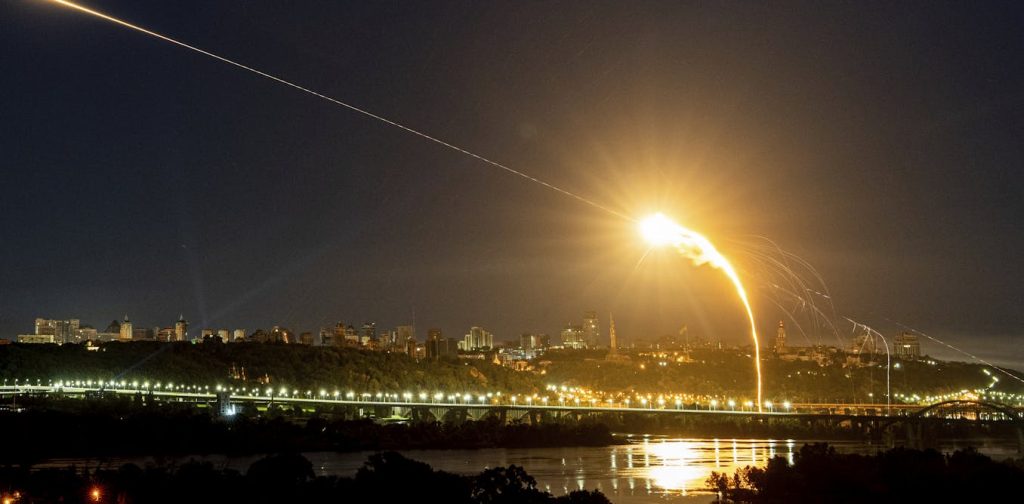Drones are the signature technology of the Ukraine war. A few miniature aircraft designs were used in the war’s early days, but an incredible array of drones have now evolved. There are different types, sizes and levels of sophistication. They are used for many roles including short- and long-range attack, reconnaissance, electronic disruption, communications relay and supply.
Many are repurposed consumer drones, such as the low-cost Chinese DJI designs sold in electronics stores. Such drones are modified as combat demands require and are being flown in their hundreds every day in Ukraine.
Before the war, military aircraft were very expensive and military forces could field very few. Drones have completely upended this situation, hugely increasing the numbers of air systems.
Ukraine is now making more than 3,000 first-person view (or FPV) drones each day (that is not a typo). These allow an operator to see from the drone’s camera in real time.
A new multinational drone coalition, of which Australia is part, plans to deliver one million of these. They can be assembled from commercially available digital electronics in small workshops and people’s homes.
Larger drones are made in purpose-built factories, but production rates remain stunning compared with modern military aircraft. The United States makes about 150 F-35 jet fighters a year. Russia’s new factory making Shahed 136 long-range attack drones will churn out 6,000 annually.
Drone defence
Wars involve actions and reactions, as each side struggles to gain advantage. The mass use of drones has inspired a rush to field a matching array of counter-drone systems.
Broadly speaking, these systems come in two kinds: those used for homeland defence and those protecting soldiers on the battlefield.
For homeland defence, the aim is to detect attacking drones, track them and try to destroy them when they come within range. The Russians often fire between 80 and 100 Shahed drones against Ukraine cities each night, usually in waves. These drones are noisy, low-flying and slow.
Efrem Lukatsky/AP Photo
Ukraine has developed an ingenious system to detect the Shahed drones. Two engineers working in a garage created a sound-detecting system using consumer mobile phones stuck on poles that can hear drones passing by.
Data from a network of 9,500 phone-on-pole sensors is then relayed to a central command post, where it is fused together to give a complete picture of what is happening in the airspace across the whole of Ukraine. Gun or missile air defences are then activated and moved as necessary to fire at passing Shahed drones.
The Ukrainian air defences generally destroy about 80% of the attacking drones.
Drones on the battlefield
Battlefield drone defence is different. Here the drones are small and quiet, and crucially are not autonomous. Each drone needs to be flown by an operator who watches the video transmitted from the drone to find the enemy forces. The aim of counter-drone efforts is primarily to evade detection, and only try to destroy the drones if there is no alternative.
Most vehicles in the battlefield have sensors to detect a drone’s communication transmission links when they are nearby. Vehicles can then speed up to make it harder for the slow-moving drones to attack, or stop and hide under overhead cover, such as trees or building awnings.
Battlefield vehicles can also carry electronic systems able to jam the drone’s communications transmission links or the drone’s GPS satellite navigation system, thereby making the drones ineffective.
First-person view drones can also chase down and attack individual soldiers. Against these, soldiers stop moving, hide in trenches and try to blend in with the background.
The Ukrainians also use a vast array of decoy systems such as wooden tanks and supply vehicles to distract Russian drone operators.
In another approach, the Russians build large chicken-wire cages around their tanks. The small first-person view drones carry only small warheads, which harmlessly detonate in the chicken wire, not on the tank itself.
The fight goes on
Drone makers are now focusing on countering the counter-drone measures. The Shahed drones are getting quieter, receiving coatings that make them harder to detect with radar, and are being painted in hard-to-see colours.
Drones, in general, also keep getting smaller, more sophisticated and cheaper. The numbers of drones in the air at any time continues to increase, allowing vast formations of drones of different kinds that support each other. Some drones in a formation might act as decoys to attract defensive systems and others might try to jam them, allowing at least some of the attack drones to survive and penetrate the defences.
A major recent step-change is the shift to make drones more autonomous. Since Russia deployed GPS-jamming systems, Ukraine has developed digital scene-matching technology so its long-range attack drones can find their targets even without GPS.
Bram Janssen / AP
For battlefield drones, both sides have drones incorporating artificial intelligence that can recognise targets and, after verification by a human operator, attack autonomously. While the target detection software is unreliable and still needs operator input, such drones are much less vulnerable to jamming of communications transmission links or GPS.
New defensive systems are emerging, too. Some first-person view drones are now being used like fighter aircraft to physically attack hostile airborne drones.
Laser systems now being trialled can dazzle a drone’s video camera, preventing the drone operator seeing possible targets. Some newer lasers can even cause physical damage to drones within a few kilometres of the laser.
The interplay between drones and drone countermeasures will continue as long as the war does.

